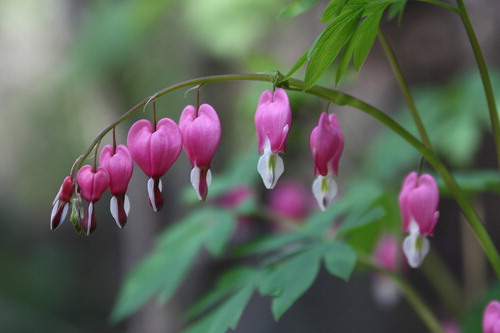Lamprocapnos spectabilis (Bleeding Heart) is a species of flowering plant belonging to the family Papaveraceae and has been valued primarily as a garden flower. We report a case of anticholinergic syndrome associated with L. spectabilis ingestion.
A 45-year-old male with a history of hypertension and chronic kidney disease (CKD) presented to our emergency department (ED) with confused mental state. A guardian stated that four persons ate steamed crucian carp 8 h before admission and then all complained of lethargy, dizziness, palpitation, and dry mouth 0.5 h after the meal. Two hours after the meal, all patients were admitted to ED of local hospital. Among these patients, our patient's wife was least symptomatic because she vomited after eating the meal. Another 2 patients improved their neurologic symptoms during local ED stay. Foley catheter was inserted in 3 patients admitted to local hospital due to urinary retention. However, only our patient was transferred to our ED because of worsening neurologic symptoms. On arrival, vital signs were blood pressure, 150/100 mmHg; heart rate, 120 beats/minute; respiratory rate, 18/minute; and ear temperature, 37.6°C. Three hours after admission, a nicardipine was injected intravenous due to high blood pressure (190/120 mmHg). Elevated blood pressure, tachycardia, and mild fever persisted on hospital day 1. Physical examination revealed dry mouth and facial flushing. Neurologic examination revealed intermittent confusion, irritability, and inability to comprehend and obey commands. Motor function was normal and there were no abnormal reflexes. Pupils were isocoric (3 mm/3 mm) and responsive to light. Laboratory findings demonstrated blood urea nitrogen (BUN) of 45 mg/dL (reference range, 8–23 mg/dL); creatinine of 5.85 mg/dL (reference range, 0.7–1.7 mg/dL); and estimated glomerular filtration rate (eGFR) of 10.6. Electrocardiography showed sinus tachycardia without QRS or QT prolongation. Brain imaging studies (CT and MRI) performed 6 h after admission did not show any acute abnormalities. There were no cells on cerebrospinal fluid examination.
The clinical manifestation suggested anticholinergic syndrome, particularly because similar symptoms and signs developed in all of those who shared a meal of steamed crucian carp, although all others improved rapidly with the exception of our patient. The chef who cooked meal stated that dried leaves of L. spectabilis were added in the main dish while adding dried radish greens. Confusion and irritability persisted and were controlled with benzodiazepine and haloperidol. Mental status started to recover 19 h after ED admission but intermittent confusion persisted. Alert mentation was achieved at 28 h after admission. Interview performed after recovery revealed that our patient ate more food than other colleagues because of preference for steamed crucian carp.
The epigeal parts and roots of L. spectabilis contain 0.17% and 0.25% total alkaloids, respectively.Citation1 Among these alkaloids, neurologic manifestations may be induced by protopine. Protopine displaces the cumulative dose–response curve for acetylcholine to the right in a parallel manner, which is characteristic for competitive antagonism.Citation2 This effect is qualitatively comparable to atropine. Protopine is rapidly distributed into brain tissue after oral administration in a rat model.Citation3 A pharmacokinetic study of protopine demonstrated that protopine was rapidly absorbed and distributed into various tissues and could effectively cross the blood–brain barrier.Citation4 Anticholinergic syndrome developed rapidly in our patient and colleagues after a shared meal. However, only our patient suffered worsening anticholinergic symptoms. This phenomenon can be explained by the amount of meal consumed and the patient's CKD. In addition, we speculate that mental changes were also due to scoulerineCitation5 which has GABAA receptor agonist property and corydineCitation6 which has narcotic-like effect.
Fig. 1. Lamprocapnos spectabilis. The flower resembles conventional heart shape. Published with permission by Su Young Jung of Korea Forest Service (colour version of this figure can be found in the online version at www.informahealthcare.com/ctx).

Declaration of interest
The authors report no declarations of interest. The authors alone are responsible for the content and writing of the paper.
References
- Israilov I, Melikov F, Murav'eva D. Alkaloids of Dicentra. Chem Nat Compd 1984; 20:74–76.
- Ustunes L, Laekeman GM, Gozler B, Vlietinck AJ, Ozer A, Herman AG. In vitro study of the anticholinergic and antihistaminic activities of protopine and some derivatives. J Nat Prod 1988; 51:1021–1022.
- Li Y, Wang P, Chen X, Ding G, Wang Z, Xiao W. Determination of protopine in rat brain after oral administration of the extract of Corydalis decumbentis. J Med Plants Res 2012; 6:4019–4023.
- Guo C, Jiang Y, Li L, Hong L, Wang Y, Shen Q, et al. Application of a liquid chromatography-tandem mass spectrometry method to the pharmacokinetics, tissue distribution and excretion studies of Dactylicapnos scandens in rats. J Pharm Biomed Anal 2013; 74: 92–100.
- Halbsguth C, Meissner O, Haberlein H. Positive cooperation of protoberberine type 2 alkaloids from Corydalis cava on the GABA(A) binding site. Planta Med 2003; 69:305–309.
- Waud R. The pharmacological action of the alkaloids of fumaraceous plants ii. Corydine. J Pharmacol Exp Ther 1935; 55:40–45.
